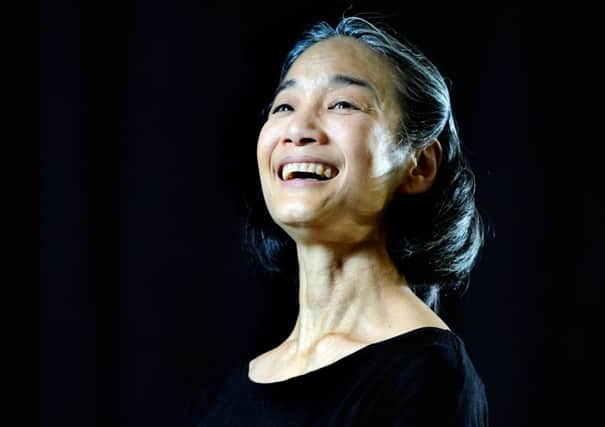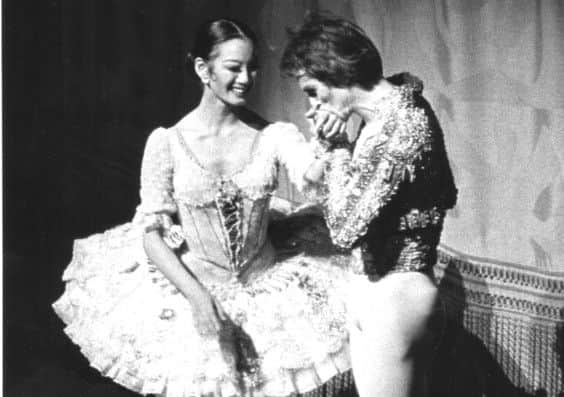Teacher who watched her step with Nureyev


And, when the time came to put away the greasepaint, Yoko Ichino did something not every top dancer is able to do: she gave herself wholeheartedly and successfully to training future generations.
A woman who seems to be pathologically modest, she tells the story of her own rise to stardom during a career that spanned three decades as though it were simply a matter of dogged hard work and happenstance.
Advertisement
Hide AdAdvertisement
Hide AdHowever, reviews of her work in the 70s, 80s and 90s, refer consistently to her flawless classical technique and the radiance that lit up the stage.


Today the long hours she puts in as ballet mistress of Leeds-based Northern Ballet mean that she provides the solid foundations of technique and stamina required by the challenging repertoire the company performs. She also customises some of the training to fit in with the physical challenges of each ballet – currently Cinderella is on tour and this week sees the revival of David Nixon’s Cleopatra, a work that requires the sharpest of precision.
But having been a top-flight dancer alone does not an inspiring and successful teacher make. This she will at least concede.
“It’s true that not every very good dancer can become a great ballet mistress or master. You have to be clear in what you are asking and in teaching the repertoire.” As associate director of the NB Academy, she is also responsible for the curriculum and methodology of classes attended by 550 students of all ages each week. She even finds time to teach some of them herself.
Advertisement
Hide AdAdvertisement
Hide AdWhen it comes to the daily ballet class with the company and the six hours of afternoon rehearsals, an eagle eye and strict attention to detail are key.
“You have to run rehearsals in a positive manner, and you have to be aware of even very small discrepancies in movement between one dancer and another.”
Such small but repeated errors as some newer dancers bring with them are usually ironed out quickly; anything more persistent is dealt with one-to-one. She does add, though, that occasionally a dancer “may not believe they are doing things wrongly at all”.
The magical illusion of ballet is that supremely difficult movements are rendered will o’ the wisp light and easy. But they only look that way thanks to many years of rigorous learning of technique and endless repetition to build up muscle memory and stamina.
Advertisement
Hide AdAdvertisement
Hide AdWatching Ichino taking the 75-minute company ballet class with all 38 dancers is mesmerising. Slow stretches at the barre move on to medium then faster exercises, gradually involving the whole body.
Eventually waves of dancers move across the floor, executing the same combination of steps, and flowing continuously around the studio back to the starting point.
Everyone is taking this class almost as seriously as a performance. There’s little banter and giggling on the sidelines; all is purposeful, disciplined and calm.
Without the distraction of embellished stage costumes, the variation in build and height in this company is more apparent, and within the class there appears to be no pecking order. Brows are glistening, patches of sweat start to spread.
Advertisement
Hide AdAdvertisement
Hide AdIchino starts off a new combination of steps with a couple of moves, graceful hand gestures and a string of French terms. She stands back and leans on the piano, her forensic gaze sweeping back and forth, spotting the smallest misjudged move.
Mostly she finds little to correct, and is all smiles. She taps one female dancer lightly on her upper back with one finger, and the neck and shoulders perceptibly relax into the right posture.
As a youngster Yoko Ichino saw ballet from afar and loved it, but her ability to dance beautifully only came to light because a doctor more or less prescribed it as being potentially beneficial to the delicate seven-year-old whose various ailments often kept her away from school.
As a Californian child of an immigrant Japanese family, money to keep the family was hard won by a father who held down five jobs to pay the bills. From the start ballet was not just the fun thing it might have been for others.
Advertisement
Hide AdAdvertisement
Hide Ad“For me it was always serious, not as it is for children now – one of a series of options,” she says. “I was the sort of child who did my best at all times. I don’t remember a conscious decision to make a career in ballet; it was more a case of whether you could make it.
“There were lots of criteria, and oriental was not ‘it’. There were very few oriental children doing ballet and you couldn’t get a scholarship. I was told (by some people) that I didn’t have the right physique to take on some of the big roles.”
Talent, hard work and determination to succeed did pay off and she was taken under the wing of celebrated teacher Mia Slavenska, making her professional debut with the Joffrey II company in 1972.
Ichino went on to dance with 22 companies around the world, met her husband-to-be David Nixon when they partnered each other in Berlin, and moved with him in 1998, when he took up his first full-time directing role at BalletMet in Columbus, Ohio.
Advertisement
Hide AdAdvertisement
Hide AdThey built up a small but successful company and school together – and Ichino realised she couldn’t continue to travel the world as a dancer in top form while also fulfilling her new role as ballet mistress with a school and company in the Midwest.
Looking back at her days of performing at top opera houses and entertaining hundreds of thousands along the way, she shrinks from name-dropping and tales of being flown half-way round the world on Concorde by New York’s American Ballet Theatre to take over the leading role in Swan Lake at short notice.
But, when pressed, she will talk a little about her experience (several times) of dancing with the genius that was Rudolf Nureyev, back in the 80s.
“He had such great presence, so I just tried to take the opportunity (to learn) from him. These opportunities came my way and I did my best to use them to improve.”
Advertisement
Hide AdAdvertisement
Hide AdOn one occasion, “Rudi” and Yoko were to dance together in Don Quixote at The Met in New York, with choreography by Mikhail Baryshnikov. The day before the opening, Nureyev had other ideas.
“It was difficult anyway, because Rudi didn’t like to rehearse. He also decided at short notice that he didn’t want to do Misha’s second act but his own [Nureyev had previously choreographed his own version of the piece].
“I knew Misha’s but had never seen Rudi’s, so at nine in the morning of the day before I was to dance it with him, I was at the Performing Arts Library watching the video over and over to learn the steps. That was what he was like – you just had to get on and do it.”
When choreographing a new ballet, David Nixon collaborates closely with the dancers, and Ichino and ballet master Daniel de Andrade (who works with the male dancers) take rehearsals.
Advertisement
Hide AdAdvertisement
Hide AdUnderpinning the teaching is the “Ichino Technique” – a holistic approach which includes science (understanding the body’s structure, how movements are made and the stresses they place on both skeleton and soft tissue), psychology and proprioception – awareness of the position of every part of the body and how it moves through the air.
“We don’t use mirrors that much, except to correct vertical movement. Where horizontal and turning moves are concerned, we do a lot of work with the eyes closed, so dancers concentrate more on where each part of their body is in relation to the rest.”
Is the cliched image of the tortured dancer constantly thwarted in his/her quest for perfection in any way a reality?
“Even the best are constantly trying to improve,” says Ichino. “It’s not about getting to the top then stopping, as that’s when you really have to work to maintain it.
Advertisement
Hide AdAdvertisement
Hide Ad“As I tell my dancers, ‘perfection is a goal, but it doesn’t exist.’ They have to work hard and stay focused; at the same time, they have to be able to say ‘today I did this well, and that well’ besides being aware of things they didn’t do so well.
“If that balance doesn’t exist, that’s when you get into trouble, no matter who or what you are. We try to help things along by having a sense of humour.”
Ichino says that in helping to make her husband’s artistic vision a reality she doesn’t offer suggestions when it comes to choreography.
“If something isn’t working in rehearsal or there is confusion, I ask him what his intention was. And sometimes, if a move is still proving a problem, he says we can change it. There’s no blueprint – we use a recording of the piece to work from.”
Advertisement
Hide AdAdvertisement
Hide AdThe company is returning this season to an acclaimed and epic ballet created by Nixon several years ago. So what’s different about Cleopatra’s second coming?
“Although the choreography is the same, we are improving on it in that many of the roles are taken by the same dancers (including the astounding Martha Leebolt in the title role created for her) but interpreted with more maturity. They are able to bring even more imagination and experience to the narrative.”
Yoko Ichino takes obvious pride in what she and David Nixon have built over the last 11 years – and playing the crucial but supporting role suits her.
“His responsibilities are enormous: repertoire, choreography, costumes – and a lot more. I make sure the dancers are in the best condition possible to achieve what he wants. I do the foundation work for him to build on. It seems to work.”
Northern Ballet’s Cleopatra is at Leeds Grand Theatre March 6 to 15. 0844 848 2700, www.leedsgrand.com; Sheffield Lyceum Theatre from March 25 to 29. 0114 249 6000, www.sheffieldtheatres.co.uk